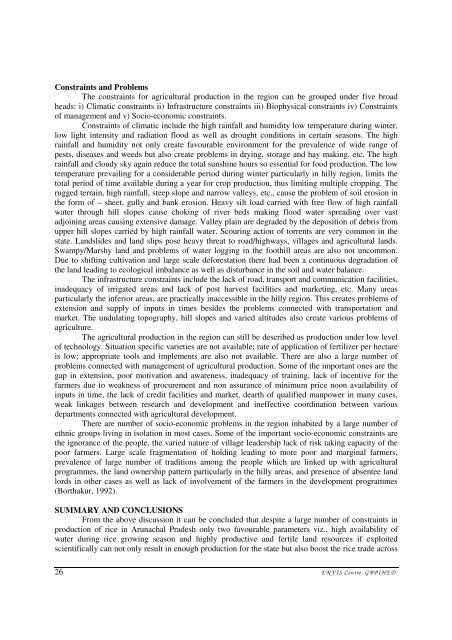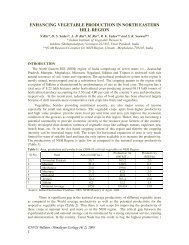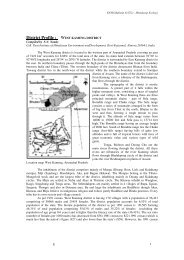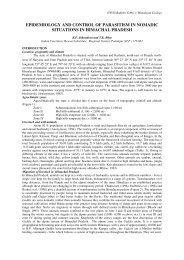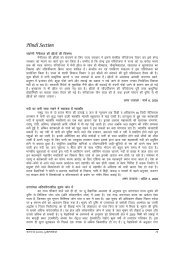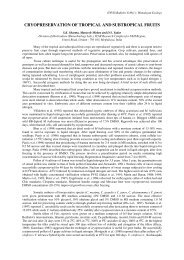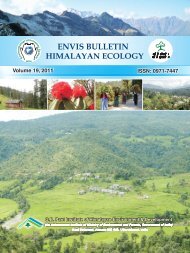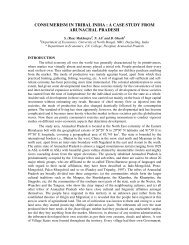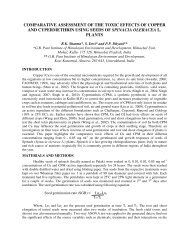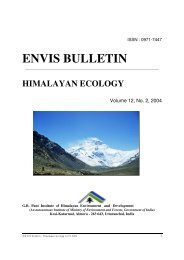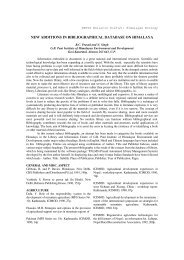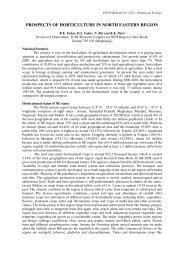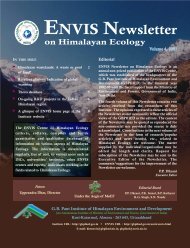Envis bulletin vol 12 1 - ENVIS Centre on Himalayan Ecology
Envis bulletin vol 12 1 - ENVIS Centre on Himalayan Ecology
Envis bulletin vol 12 1 - ENVIS Centre on Himalayan Ecology
Create successful ePaper yourself
Turn your PDF publications into a flip-book with our unique Google optimized e-Paper software.
C<strong>on</strong>straints and Problems<br />
The c<strong>on</strong>straints for agricultural producti<strong>on</strong> in the regi<strong>on</strong> can be grouped under five broad<br />
heads: i) Climatic c<strong>on</strong>straints ii) Infrastructure c<strong>on</strong>straints iii) Biophysical c<strong>on</strong>straints iv) C<strong>on</strong>straints<br />
of management and v) Socio-ec<strong>on</strong>omic c<strong>on</strong>straints.<br />
C<strong>on</strong>straints of climatic include the high rainfall and humidity low temperature during winter,<br />
low light intensity and radiati<strong>on</strong> flood as well as drought c<strong>on</strong>diti<strong>on</strong>s in certain seas<strong>on</strong>s. The high<br />
rainfall and humidity not <strong>on</strong>ly create favourable envir<strong>on</strong>ment for the prevalence of wide range of<br />
pests, diseases and weeds but also create problems in drying, storage and hay making, etc. The high<br />
rainfall and cloudy sky again reduce the total sunshine hours so essential for food producti<strong>on</strong>. The low<br />
temperature prevailing for a c<strong>on</strong>siderable period during winter particularly in hilly regi<strong>on</strong>, limits the<br />
total period of time available during a year for crop producti<strong>on</strong>, thus limiting multiple cropping. The<br />
rugged terrain, high rainfall, steep slope and narrow valleys, etc., cause the problem of soil erosi<strong>on</strong> in<br />
the form of – sheet, gully and bank erosi<strong>on</strong>. Heavy silt load carried with free flow of high rainfall<br />
water through hill slopes cause choking of river beds making flood water spreading over vast<br />
adjoining areas causing extensive damage. Valley plain are degraded by the depositi<strong>on</strong> of debris from<br />
upper hill slopes carried by high rainfall water. Scouring acti<strong>on</strong> of torrents are very comm<strong>on</strong> in the<br />
state. Landslides and land slips pose heavy threat to road/highways, villages and agricultural lands.<br />
Swampy/Marshy land and problems of water logging in the foothill areas are also not uncomm<strong>on</strong>.<br />
Due to shifting cultivati<strong>on</strong> and large scale deforestati<strong>on</strong> there had been a c<strong>on</strong>tinuous degradati<strong>on</strong> of<br />
the land leading to ecological imbalance as well as disturbance in the soil and water balance.<br />
The infrastructure c<strong>on</strong>straints include the lack of road, transport and communicati<strong>on</strong> facilities,<br />
inadequacy of irrigated areas and lack of post harvest facilities and marketing, etc. Many areas<br />
particularly the inferior areas, are practically inaccessible in the hilly regi<strong>on</strong>. This creates problems of<br />
extensi<strong>on</strong> and supply of inputs in times besides the problems c<strong>on</strong>nected with transportati<strong>on</strong> and<br />
market. The undulating topography, hill slopes and varied altitudes also create various problems of<br />
agriculture.<br />
The agricultural producti<strong>on</strong> in the regi<strong>on</strong> can still be described as producti<strong>on</strong> under low level<br />
of technology. Situati<strong>on</strong> specific varieties are not available; rate of applicati<strong>on</strong> of fertilizer per hectare<br />
is low; appropriate tools and implements are also not available. There are also a large number of<br />
problems c<strong>on</strong>nected with management of agricultural producti<strong>on</strong>. Some of the important <strong>on</strong>es are the<br />
gap in extensi<strong>on</strong>, poor motivati<strong>on</strong> and awareness, inadequacy of training, lack of incentive for the<br />
farmers due to weakness of procurement and n<strong>on</strong> assurance of minimum price no<strong>on</strong> availability of<br />
inputs in time, the lack of credit facilities and market, dearth of qualified manpower in many cases,<br />
weak linkages between research and development and ineffective coordinati<strong>on</strong> between various<br />
departments c<strong>on</strong>nected with agricultural development.<br />
There are number of socio-ec<strong>on</strong>omic problems in the regi<strong>on</strong> inhabited by a large number of<br />
ethnic groups living in isolati<strong>on</strong> in most cases. Some of the important socio-ec<strong>on</strong>omic c<strong>on</strong>straints are<br />
the ignorance of the people, the varied nature of village leadership lack of risk taking capacity of the<br />
poor farmers. Large scale fragmentati<strong>on</strong> of holding leading to more poor and marginal farmers,<br />
prevalence of large number of traditi<strong>on</strong>s am<strong>on</strong>g the people which are linked up with agricultural<br />
programmes, the land ownership pattern particularly in the hilly areas, and presence of absentee land<br />
lords in other cases as well as lack of in<str<strong>on</strong>g>vol</str<strong>on</strong>g>vement of the farmers in the development programmes<br />
(Borthakur, 1992).<br />
SUMMARY AND CONCLUSIONS<br />
From the above discussi<strong>on</strong> it can be c<strong>on</strong>cluded that despite a large number of c<strong>on</strong>straints in<br />
producti<strong>on</strong> of rice in Arunachal Pradesh <strong>on</strong>ly two favourable parameters viz., high availability of<br />
water during rice growing seas<strong>on</strong> and highly productive and fertile land resources if exploited<br />
scientifically can not <strong>on</strong>ly result in enough producti<strong>on</strong> for the state but also boost the rice trade across<br />
26<br />
E N V IS <str<strong>on</strong>g>Centre</str<strong>on</strong>g>, G B P IH E D


